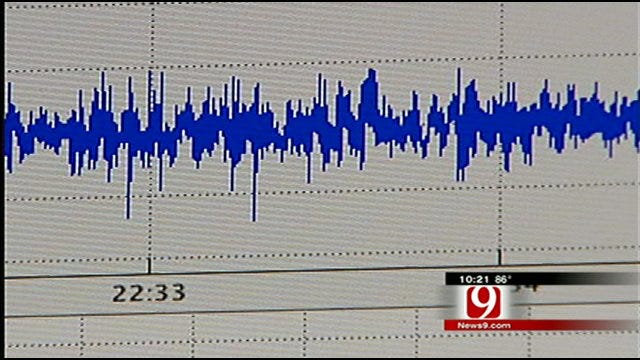Oklahoma Earthquake Swarm: Lots Of Data, But Few Answers
Researchers at the Oklahoma Geological Survey have been cataloguing earthquakes in the state for more than 100 years, but never have they had so many to catalogue or been so baffled as to their underlying cause.Tuesday, June 7th 2011, 12:26 pm
Alex Cameron, Oklahoma Impact Team
Norman, OK -- Researchers at the Oklahoma Geological Survey have been cataloguing earthquakes in the state for more than 100 years, but never have they had so many to catalogue or been so baffled as to their underlying cause.
"We have this really high quality data set," remarked research seismologist Austin Holland, "and there's no clear answer popping out as to what's going on."
Holland presented his data, in poster form, at the Seismological Society of America's annual conference in Memphis in late April.
Austin Holland Research Poster
The title of his poster (a precursor to the academic paper he intends to eventually publish) sums up, in simple terms, what's going on -- "Jones, Oklahoma Earthquake Swarm." The small town of Jones (pop. 2517), in eastern Oklahoma County (about 14 miles northeast of downtown Oklahoma City) has been at the center of an unusual surge in seismic activity over the past 18 months.
According to the Geological Survey, there were a total of six earthquakes in Oklahoma County from 2000 through 2008. The uptick began in 2009, when monitoring equipment recorded 31 earthquakes in the county. Over the ensuing 15 months -- January 2010 through March 2011 -- Holland says there were 850 earthquakes, just in Oklahoma County.
"To put that into perspective," Holland said, "the most earthquakes we'd ever recorded in a single year in [the entire state of] Oklahoma was 167."
The majority of the tremors have not been strong enough to be felt, but more than 100 have. (The threshold, above which earthquakes, generally, are said to be 'felt,' is around 2.5 on the Richter scale.) And Holland believes the number is probably higher, presuming that, as the quakes became more common, residents would have been less inclined to report those of lower magnitudes.
At the same time, experts say the number of earthquakes recorded since the onset of the swarm has likely been bolstered by the placement of additional monitoring stations in the region.
Still, no one questions the fact that the amount of recent seismic activity in central Oklahoma is very much above the norm and begs for an explanation.
A common theory, among those who live in and around Jones, is that oil and gas activity underground is triggering the earthquakes. Recent incidents in Great Britain, Arkansas, and Dallas/Fort Worth have lent credence to that theory. In those cases, oil and gas companies voluntarily shut down aspects of local drilling operations, in response to concerns that they might have had something to do with unexpected seismic events.
There is unrefuted evidence that the injection of fluids deep into the earth, at high pressure and in proximity to existing faults, can produce small earthquakes, but Holland strongly doubts that there is any such correlation in the aforementioned cases.
In the case of the Jones swarm, Holland says, while the data may not point to a clear answer, it also does not point to drilling.
"It continues to be a possibility," Holland admitted, "but the connections are weak, and it would take much more research and a greater understanding of what's going on in the sub-surface to begin to attribute this to oil and gas activities."
The types of high-pressure, high-volume injection wells that, in theory, could cause small tremors do exist in central Oklahoma, but Holland says the epicenters of the earthquakes are too diffuse and not spatially aligned in the way he would expect if they were tied to those wells.
For that reason, primarily, Holland is convinced the quakes are not anthropomorphic.
"At the moment, I definitely-- my gut is saying this is naturally occurring seismicity within the region," Holland posited.
Holland believes naturally-occurring, east-west pressures are squeezing Oklahoma and causing slips along existing faults.
"If you get one earthquake to occur, it changes the state of stress around it," Holland explained, "and then you can then cause this chain reaction to occur, when then another earthquake occurs, and another."
Holland says it will take further research and additional data to prove his theory. Even then, he knows, it would not explain why this is happening now, nor would it adequately account for the sheer size of the swarm.
And that's why, Holland says, he's still not ruling out anything.
More Like This
June 7th, 2011
April 23rd, 2025
Top Headlines
April 25th, 2025
April 25th, 2025
April 25th, 2025
April 25th, 2025












